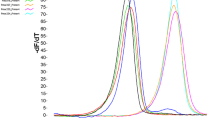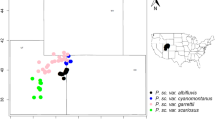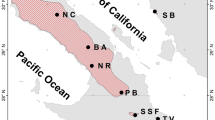Abstract
The common reed,Phragmites australis, is a common feature in wetlands across North America. Recent studies have suggested that the widespread invasions of this species may be due to the introduction of a non-native strain from EurAsia. Since native population types is needed to facilitate management of ulations are also found, a method for distinguishing population persist in many areas where introduced populations are also found, a method for distinguishing population types is needed to facilitate management of the species. A restriction fragment length polymorphism (RFLP) assay was developed to distinguish native, non-native, and Gulf Coast type populations ofPhragmites from each other. Two amplified non-coding chloroplast DNA regions are each cut with one restriction enzyme, allowing the distinction of native, non-native and Gulf Coast haplotypes from each other. When used together, these cut sites provide a low cost, rapid way of determining the origin ofPhragmites populations.
Similar content being viewed by others
Literature Cited
Bertness, M. D., P. J. Ewanchuk, and B. R. Silliman. 2002. Anthropogenic modification of New England salt marsh landscapes. Proceedings of the National Academy of Sciences USA 99:1395–1398.
Doyle, J. J. and E. E. Dickson. 1987. Preservation of plant samples for DNA restriction endonuclease analysis. Taxon 36:715–722.
Marcinko-Kuhn, M., J. Minor, and B. N. White. 1999. A molecular examination of hybridization between cattail speciesTypha latifolia andTypha angustifolia using RAPD and chloroplast DNA markers. Molecular Ecology 8:1981–1990.
Marks, M., B. Lapin, and J. Randal. 1994.Phragmites australis (P. communis): threats, management, and monitoring. Natural Areas Journal 14:285–294.
McIvor, L., C. A. Maggs, J. Provan, and M. J. Stanhope. 2001.rbcL sequences reveal multiple cryptic introductions of the Japanese red algaPolysiphonia harveyi. Molecular Ecology 10:911–919.
Mohanty, A., J. P. Martin, and I. Aguinagalde. 2001. Chloroplast DNA study in wild populations and some cultivars ofPrunus avium L. Theoretical and Applied Genetics 103:112–117.
Pellegrin, D. and D. P. Hauber. 1999. Isozyme variation among populations of the clonal species,Phragmites australis (Cav.) Trin. ex Steudel. Aquatic Botany 63:241–259.
Rieseberg, L. H., R. Carter, and S. Zona. 1990. Molecular tests of the hypothesized hybrid origin of two diploidHelianthus species (Asteraceae). Evolution 44:1498–1511.
Roman, C. T., W. A. Niering, and R. S. Warren. 1984. Salt marsh vegetation changes in response to tidal restrictions. Environmental Management 8:141–150.
Saltonstall, K. 2001. A set of primers for amplification of noncoding regions of chloroplast DNA in the grasses. Molecular Ecology Notes 1:76–78.
Saltonstall, K. 2002. Cryptic invasion by a non-native genotype of the common reed,Phragmites australis, into North America. Proceedings of the National Academy of Sciences USA 99:2445–2449.
Saltonstall, K. 2003a. Genetic variation among North American populations ofPhragmites australis: implications for management. Estuaries 26(2B):445–452.
Saltonstall, K. 2003b. Microsatellite variation within and among North American lineages ofPhragmites australis. Molecular Ecology 12(7):1689–1702.
Soltis, D. E., M. A. Gitzendanner, D. D. Strenge, and P. S. Soltis. 1997. Chloroplast DNA intraspecific phylogeography of plants from the Pacific Northwest of North America. Plant Systematics and Evolution 206:353–373.
Taberlet, P., L. Gielly, G. Pautou, and J. Bouvet. 1991. Universal primers for amplification of three non-coding regions of chloroplast DNA. Plant Molecular Biology 17:1105–1109.
Author information
Authors and Affiliations
Rights and permissions
About this article
Cite this article
Saltonstall, K. A rapid method for identifying the origin of North AmericanPhragmites populations using RFLP analysis. Wetlands 23, 1043–1047 (2003). https://doi.org/10.1672/0277-5212(2003)023[1043:ARMFIT]2.0.CO;2
Received:
Revised:
Accepted:
Issue Date:
DOI: https://doi.org/10.1672/0277-5212(2003)023[1043:ARMFIT]2.0.CO;2




